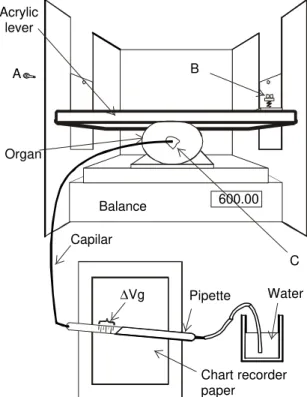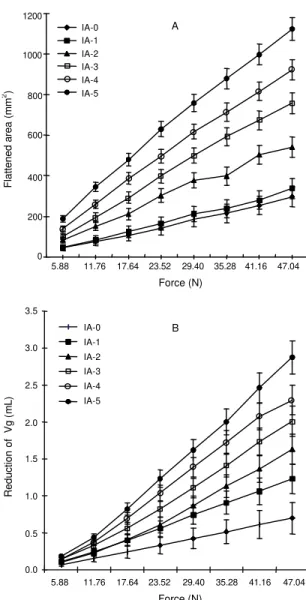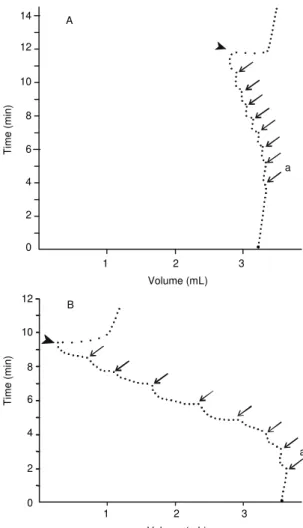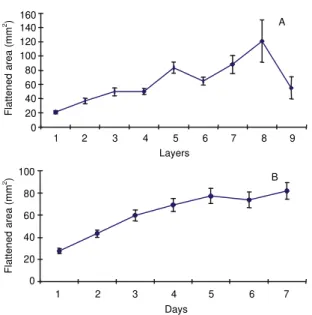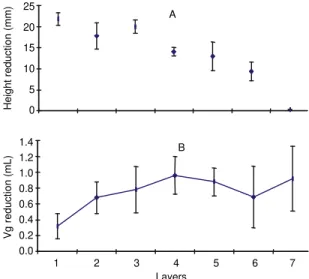ELASTIC STRESSES AND PLASTIC DEFORMATIONS IN ‘SANTA CLARA’
TOMATO FRUITS CAUSED BY PACKAGE DEPENDENT COMPRESSION
1ADRIANA VARGAS PEREIRA2 and ADONAI GIMENEZ CALBO3
ABSTRACT - The objective of this work was to study the fruit compression behavior aiming to
de-velop new tomato packages. Deformations caused by compression forces were observed inside pack-ages and in individual ‘Santa Clara’ tomato fruit. The forces applied by a transparent acrylic lever to the fruit surface caused pericarp deformation and the flattened area was proportional to the force mag-nitude. The deformation was associated to the reduction in the gas volume (Vg), caused by expulsion of the air from the loculus cavity and reduction in the intercellular air volume of the pericarp. As ripening advanced, smaller fractions of the Vg reduced by the compressive force were restored after the stress was relieved. The lack of complete Vg restoration was an indication of permanent plastic deformations of the stressed cells. Vg regeneration (elastic recovery) was larger in green fruits than in the red ones. The ratio between the applied force and the flattened area (flattening pressure), which depends on cell turgidity, decreased during ripening. Fruit movements associated with its depth in the container were observed during storage in a transparent glass container (495 x 355 x 220 mm). The downward move-ment of the fruits was larger in the top layers because these movemove-ments seem to be driven by a summa-tion of the deformasumma-tion of many fruits in all layers.
Index terms: Lycopersicon esculentum, mechanical damage, porosity, storage losses.
ESTRESSES ELÁSTICOS E DEFORMAÇÕES PLÁSTICAS EM FRUTOS DE TOMATEIRO ‘SANTA CLARA’ CAUSADOS PELA COMPRESSÃO NA EMBALAGEM
RESUMO - O objetivo deste trabalho foi avaliar a compressão dos tomates dentro das embalagens,
com vistas ao desenvolvimento de novos tipos de embalagem.Deformações causadas por compressão foram observadas em frutos de tomateiro ‘Santa Clara’, dentro e fora da embalagem. A força aplicada com uma alavanca de acrílico transparente causou deformações no pericarpo, e a área amassada foi proporcional ao módulo da força. Essas deformações foram associadas à redução do volume gasoso do fruto (Vg), que foi expulso da cavidade locular e dos espaços intercelulares do pericarpo. À medida que o amadurecimento avançou, menores frações do Vg foram restauradas após o alívio do estresse. A falta de restauração completa do Vg foi uma indicação de deformação plástica permanente nas célu-las estressadas. A restauração elástica do Vg foi maior nos frutos verdes do que nos frutos amadureci-dos. A razão entre a força aplicada e a área amassada, a qual depende da turgidez celular, diminuiu durante o amadurecimento. Movimentos de frutos associados com a profundidade foram observados no interior de uma caixa de vidro transparente (495 x 355 x 220 mm). O movimento descendente dos frutos foi maior nas camadas superiores, porque estes movimentos são causados pela soma das defor-mações de frutos nas diferentes camadas.
Termos para indexação: Lycopersicon esculentum, danos mecânicos, porosidade, perdas por armazenamento.
INTRODUCTION
In Brazil, the traditional wooden boxes (K boxes)
used to transport tomatoes (Lycopersicon
esculentum Mill) are too deep (355 mm) and
fre-quently cause fruit deformations, which seem not to
be completely reversible. Changes in shape,
soften-1Accepted for publication on April 10, 2000.Part of a thesis presented by the senior author to Universidade de Brasília.
2Agronomist, M.Sc. E-mail: vargas.a@bol.com.br
ing and water soaking are common symptoms of
com-pression stress, which cause severe losses in soft fruits
such as tomatoes and strawberries (Sargent et al.,
1992). Compression-induced deformations are
caused by deforming components at the cellular and
intercellular levels (Calbo et al., 1995).
Intercellular spaces are the main route for gas
ex-change in plants and their constriction by
compres-sion affects O
2intake and other gas exchange
pro-cesses. Reduction of the O
2concentration in
com-pressed tissues of ripe and unripe tomato fruit was
observed by Calbo et al. (1995).
Sealed roots, tubers and fruits, with the internal
atmosphere kept at ambient barometric pressure
(9.13 x 10
-2MPa), had the air contained inside the
intercellular volumes dislodged, when they were
sub-jected to pressures above the turgor pressure (Calbo
et al., 1995). Upon decompression, the elastic
recov-ery of the cells was incomplete and the final
intercel-lular air volume was smaller than it was before the
compression stress. The data suggested plastic
de-formations associated with the strong adhesion among
cells. Similar plastic effects over the intercellular
gaseous network were also observed with the aid of
the differential mass volume method in tomato fruit
subjected to several linear deformations (Calbo &
Nery, 1995b).
The objective of this work was to study the fruit
compression behavior aiming to develop new tomato
fruit packages.
MATERIAL AND METHODS
Tomato fruits (Lycopersicon esculentum cv. Santa Clara) produced in Brasília, DF, Brazil, were carefully har-vested and brought to the postharvest laboratory at Embrapa-Centro Nacional de Pesquisa de Hortaliças in plastic boxes covered with soft plastic foam. In the labo-ratory, fruits were selected for freedom from defects and physiological, and pathological disorders.
The ripening index was evaluated as follows: 0- ma-ture green fruit; 1- fruit with no more than 10% of its sur-face tannish-yellow (breaker); 2- fruit with 10% to 30% of its surface tannish-yellow or pink (turning); 3- fruit with 30 to 60% of its surface pink or red (pink); 4- fruit with 60 to 90% of its surface red (light red), and 5- fruit with more than 90% of its surface red. This numerical ripening index sequence is based on the USDA ripening criteria (Ryall &
Lipton, 1979), which is also followed by several Brazilian ‘Santa Cruz’ derived tomato cultivars.
Fruit compression in the package
A glass box with a base of 495 x 220 mm and 355 mm of height was used to study fruit surface flattening, inter-cellular air volume deformations and changes of fruit po-sition in the (package) box. In this assay, every layer within the box was considered one treatment, and the fruits from each layer were the replicates.
The arrangement of the fruits inside the box was alea-tory, because the fruits are randomly placed inside the boxes as used in the Brazilian commercial practice.
During the storage in the glass box, the fruit flattened areas against the wall, the movement of its central point and its ripening color were recorded daily. The height be-tween the box base and the center of the flattened figure, formed by the compression of each fruit against the wall, was used to evaluate horizontal fruit movement. This flat-tened ellipsoidal area (A) was estimated from its largest diameter (a) and its smallest diameter (b) using the for-mula A = πab/4.
In one experiment methylene blue staining of the fruit inside the "K box" (dimensions 495 x 220 x 355 mm) was used to evaluate the number of contact areas among the fruit. An alcoholic solution of methylene blue 1 mL/L was copiously poured on the top of the box. After drying the fruit with a forced air flow, they were separated onto trays according to their layers. Only the contact areas among fruits remained unstained and the number of contact areas of each fruit were then recorded.
Elastic recovery
To study plastic deformations and the elastic recovery of tomato fruits with ripening indexes of 0, 1, 2, 3, 4 and 5, each tomato was submitted to a compression force of 4.53 N for 24 hours at 24±2oC and 68% of relative
hu-midity in the compression apparatus (Silva & Calbo, 1992). In this assay the ripening indexes (treatments) were ran-domly replicated six times.
After decompression, the elastic recovery was followed according to the movement of the water pulled into the pipette. A volume correction for respiration error was made with the aid of the initial 10 min respiratory baseline as previously described by Calbo & Nery (1994) and Calbo et al. (1995). This respiration baseline followed a linear pattern for more than 40 min, during which the elastic re-covery was observed. For longer experimental periods, oxygen depletion in the fruit internal atmosphere resulted in anaerobic respiration. The observed water movement was caused by O2 consumption, which occurred because
the O2 solubility in the tissues is about 30 times smaller
than the CO2 solubility (Nery & Calbo, 1994).
Mass and volume of each fruit were measured before and after the assay to determine the residual plastic defor-mation of each fruit, assumed to be equal to the fruit inter-cellular air volume reduction measured by the differential mass-volume method (Calbo & Nery, 1995b).
Rapid elastic and plastic deformations
In a completely randomized assay, with 10 replicates, compression forces of 5.88, 11.76, 23.52, 29.40, 35.28, 41.16 or 47.04 N were applied to fruits with different rip-ening indexes using an acrylic lever placed on the top of an electronic balance (Fig. 1). Before and after compres-sion, the fruit mass and volume were recorded for differ-ential estimation of the plastic residual deformation, ac-cording to the changes of the remaining intercellular vol-ume made with the differential mass-volvol-ume method (Calbo & Nery, 1995b). A 10 min respiratory baseline was also recorded for each fruit to discount the linear volu-metric gaseous reduction caused by O2 consumption
(Calbo & Nery, 1994; Calbo et al., 1995).
After the application of 47.04 N, the fruit was decom-pressed rapidly and the elastic recuperation was observed in a pipette, in a similar way of the experiment to study elastic recovery and residual deformation after a 24 hour stress, as described above.
RESULTS AND DISCUSSION
The turgor pressure dependent firmness, i.e. ratio
between the applied force and the flattened area,
de-creased during ripening (Fig. 2) and was
indepen-dent of the applied force. Consistent with this
obser-vation, the flattened areas and the volume of gas
removed, Vg, caused by fruit compression, increased
with the applied force and with fruit ripening (Fig. 3).
The internal fruit deformation was divided into a
plastic irreversible component and a reversible
elas-tic component. The elaselas-tic Vg recovery was intense
only during a few minutes following decompression
(Fig. 4). This elastic recovery was more intense in
green fruit (Fig. 5A), while intense plastic
deforma-tions indented fruit with more advanced ripening
(Fig. 5B).
In fruit submitted to a 4.53 N force for 24 hours,
reduced plastic and elastic deformations were
ob-served. The differences between fruit in different
rip-ening stages could not be demonstrated in this
par-ticular assay because the applied compression force
was too small.
FIG. 1. Experimental arrangement to apply forces while fruit deformation was measured accord-ing to the removed air quantity. A - Acrylic lever with retaining pins to deform the fruit; B - Screw and spring for force adjustment at the acrylic lever (A), the magnitude of the force was evaluated in the balance; C - Peduncle connection for the internal atmosphere, com-posed of a 2.5 mm PVC disk with an attach-ment hole for the plastic tube externally glued to the tomato fruit by a plastic sealant. Acrylic
lever
A
Organ
B
∆Vg Pipette Water
C
Chart recorder paper
Balance 600.00
For fruit stored in the glass boxes, with the same
dimensions as the Brazilian K box, the flattened
ar-eas of the fruit against the walls incrar-eased from the
top to the bottom layers (Fig. 6A). This result was
expected considering the previously observed
linear-ity between deformation and applied load. These
flat-tened areas increased with time during the assay, fast
at the beginning and then very slowly towards the
end (Fig. 6B).
The average number of flattened areas per fruit
was very close to 6.0 in the whole box (Fig. 7). Fruits
of the top layer had an average of only 3.5 contact
areas, likewise the number of contact areas was also
small in the bottom layer. In all other layers this
num-ber was approximately 6.0.
In four similar assays inside K boxes the
compres-sion force increased from the top to the bottom.
How-ever, in some cases the bottom layer, subjected to
heavier load, presented more fruit, because of the
natural way the fruit use the empty volumes as they
fall randomly in the box. In these instances those
bottom fruits were subjected to a slightly smaller
com-pression and had a slightly smaller flattened area than
the fruit from the immediately above layer.
The fruit deformation inside the static glass box
caused downward movements of the fruit (Fig. 8).
Downward movement was greatest for the top layer.
The bottom layer height change in the flattened
el-lipsoid centers was negligible (Fig. 9A).
Fruit Vg as a function of layer in the packages
was similar to fruit Vg as a function of force in the
individual fruit assay. The box assay, however, had a
poorer resolution to separate reductions in Vg caused
FIG. 2. Flattening pressure (MPa) of ‘Santa Clara’ to-mato fruit submitted to a force of 47.04 N with different USDA ripening indexes during an assay at 23±2oC.
0 1 2 3 4 5
Flattening
pressure (
MPa)
Ripening index
0.20
0.15
0.10
0.05
0.00
FIG. 3. Flattened area (A) and reduction of the gas-eous volume (B) of ‘Santa Clara’ tomato fruit as a function of the applied compression force. The ripening index number (IA) followed the USDA ripening criteria. T = 23±2oC. Baromet-ric gas pressure 91,300 Pa.
Flattened
area (mm
2)
5.88 11.76 17.64 23.52 29.40 35.28 41.16 47.04
Force (N)
1200
1000
800
600
400
200
0
IA-0 IA-1 IA-2 IA-3 IA-4 IA-5
A
IA-0 IA-1 IA-2 IA-3 IA-4 IA-5
B
5.88 11.76 17.64 23.52 29.40 35.28 41.16 47.04
Force (N)
3.5
3.0
2.5
2.0
1.5
1.0
0.5
0.0
Reduction
of
Vg (
by compression. In a 13-day compression assay the
plastic intercellular deformation increased towards
the bottom of the box (Fig. 9B).
Similar to other tomato cultivars (Freitas, 1995;
Resende, 1995; Souza, 1995), the turgor dependent
firmness, measured as a ratio between the applied
force and the flattened area (Calbo & Calbo, 1989;
Calbo & Nery, 1995a), decreased
during ripening
(Fig. 2). The flattening pressure obtained for each
ripening index of ‘Santa Clara’ tomato fruit had a
magnitude similar to the turgor observed in a
pres-sure probe study of Shackel et al. (1991) in ripening
tomatoes. One possible explanation of the reduction
of turgor in tomatoes during ripening is the
reduc-tion for the solute pumping from the apoplast to the
simplast, which causes an increase in the
concentra-tion of solutes in the apoplast as observed by Shackel
et al. (1991).
The flattened area and the Vg reduction divided
by the applied force yield nearly constant ratios as a
function of applied force for each ripening index.
These ratios, which were indicative of the fruit
sus-ceptibility to compression, increased during
ripen-ing (Fig. 3). An explanation to this phenomenon is
the expulsion of intercellular air volumes through the
peduncle insertion (Fig. 4) and possibly some changes
FIG. 4. Typical gas efflux from ‘Santa Clara’ tomato fruits submitted to increasing compression forces. Observations were made in the appa-ratus presented in Fig. 1. (a) start of compres-sion. (→) Moment of addition of each 5.88 N force increment. (
?
) Decompression occurred after the applied force reached 47.04 N. After the end of the Vg recovery, the base line incli-nation caused by O2 consumption returned to the initial value. A - mature-green fruit; B - red fruit. T = 23±2oC. Barometric gas pressure 91,300 Pa.a A
1 2 3
Volume (mL)
Time (min)
1 2 3
Volume (mL)
Time (min)
a B
14
12
10
8
6
4
2
0
12
10
8
6
4
2
0
FIG. 5. Elastic gaseous volume recovery after decompression (A) and residual plastic defor-mation observed 24 hours after decompression of ‘Santa Clara’ tomato (B). Fruits with USDA ripening indexes of 0 to 5 were compressed by forces up to 47.04 N, as illustrated in Fig. 4, for this assay at T = 23±2oC. Vg = gaseous vol-ume. Barometric gas pressure 91,300 Pa.
0 1 2 3 4 5
Ripening indexes 80
70 60 50 40 30 20 10 0
Vg
recovery (%)
3.0
2.5
2.0
1.5
1.0
0.5
0.0
Vg
plastic
deformation (
mL)
A
in the cell shape and some local water transport from
compressed to uncompressed cells, as suggested by
Calbo et al. (1995).
The plastic deformation of each fruit under a
con-stant load increased with fruit ripening (Fig. 5B),
while the rapid elastic fruit gaseous volume
recov-ery was reduced during ripening (Fig. 5A). The
ex-istence of gluing components in the external surface
of the cell walls facing intercellular volumes (Steckel
et al., 1995) and the turgor reduction during
ripen-ing (Shackel et al., 1991) (Fig. 2) are the possible
interdependent causes for the much smaller elastic
gas volume recovery in red fruits.
Calbo et al. (1995) suggested that the rapid initial
Vg recovery in mature-green fruits is due mainly to
the locular wall movement. The methods employed
to evaluate fruit deformation in the present work were
not appropriate to discriminate loculus movement and
pure intercellular deformation, consequently, this
question remains unsolved, requiring new
experimen-tal approaches.
In the assays herein reported, direct observation
of sap efflux through the peduncle of compressed
fruits occurred only in one case for a completely red
fruit subjected to an axial compression of 47.04 N.
In tomatoes transported in large trucks to the
indus-try, similar sap efflux and localized anaerobiosis may
FIG. 6. (A) Flattened area per tomato fruit (cv. Santa Clara) after 8 days of storage in a K box, pooled over days. (B) Average flattened area as a func-tion of storage time, pooled over layers. Turn-ing fruits usually become completely red dur-ing this assay. T = 24±2oC.
1 2 3 4 5 6 7
Days 100
80
60
40
20
0
Flattened
area (mm
2) B
160 140 120 100 80 60 40 20 0
Flattened
area (mm
2)
1 2 3 4 5 6 7 8 9
Layers
A
FIG. 7. Number of surrounding tomatoes per fruit ac-cording to its layer in a wooden K box (495 x 355 x 220 mm).
8
7
6
5
4
3
2
Number
of
contact
areas
1 2 3 4 5 6 7
Layers
FIG. 8. Typical movement of ‘Santa Clara’ tomato fruit stored in a glass box of 495 x 355 x 220 mm placed on top of a static bench at 24±2oC. Each point represents the position of the center of the flattened area on the day of the measurement. (→) Initial fruit position. A - Fruit from layer 1 (top); B - fruit from layer 3; C - fruit from layer 5; D - fruit from layer 7.
80
70
60
50
40
30
20
10
0
Vertical (mm)
0 10 20 30 40 50 60 70 80
Horizontal (mm)
A B
occur with frequency, since the very ripe fruits used
for canning always have high apoplasmic hydrostatic
pressures, and are subjected to large estimated
com-pression. Along this line, Calbo et al. (1995) showed
that local axial compressions cause small changes in
the total amount of gas contained inside tomato fruit,
and large local reductions of the internal
concentra-tion of O
2. These local O
2deprivations are caused
by partial and sometimes total obstruction of the
in-tercellular gas paths, which have their volume reduced
and eventually become flooded by the dialyzed
cell water.
Flattened areas of the fruits facing the walls of the
glass box increased with layer depth (force) (Fig. 6A)
and, at the same time, the fruit internal deformation
increased, according to the fruit internal gas volume
reduction (Fig. 9B). This result is a confirmation of
the previous experiment and indicates irreversible
internal damage in these compressed fruits.
Deformations of fruit stored in static boxes caused
mainly downward movements of the fruit layers
(Fig. 8 and Fig. 9A). This downward movement
could, at a given layer, be considered as the
summa-tion of the deformasumma-tions of the fruits in all layers
be-low that particular one.
Damages caused by compression proved to be
largely irreversible. Under vibrations and other causes
of fruit rotation new undamaged pericarp surfaces
can be exposed to compression damage. As a
conse-quence, compression damage described in this static
load study represents a lower damage limit.
CONCLUSIONS
1. For each ripening index the flattened area
in-creases in a direct proportion to the applied force.
2. At constant applied forces the flattened area
increases with fruit ripening.
3. The close proportionality between force and
flattened area suggests a flattening pressure
depen-dent on cell turgor.
4. The gaseous volume inside a tomato fruit is
reduced proportionally to the compressive force.
5. The fruit capacity to recover from a
deforma-tion induced by a compression force decreases with
fruit ripening.
6. Boxes with more than four layers of fruits causes
irreversible fruit damage.
ACKNOWLEDGEMENTS
To CNPq, for the scholarship to the first author
and the second author research grant; to Amaury
Alves Nery, for the skillful laboratory assistance and
firmness evaluation and for the helpful discussions;
to José Luiz Oliveira da Silva, for the work in the
methylene blue assay in which average flatted areas
per layer and the number of fruit neighbors were
evaluated.
REFERENCES
CALBO, A.G.; CALBO, M.E.R. Medição e importância do potencial de parede. Revista Brasileira de Fisiologia Vegetal, Brasília, v.1, n.1, 41-45, 1989.
CALBO, A.G.; NERY, A.A. A medida de firmeza pela técnica de aplanação. Horticultura Brasileira,
Brasília, v.13, n.1, p.14-18, 1995a.
FIG. 9. Height reduction (A) and gaseous volume reduction (B) of Santa Clara tomato fruits stored in the glass box 495 x 355 x 220 mm for 13 days at 24±2oC and relative humidity of 60%. The layers were enumerated starting from the top. Vg - gaseous volume. Baromet-ric gas pressure 91,300 Pa.
1.4 1.2 1.0 0.8 0.6 0.4 0.2 0.0
Vg
reduction (
mL)
1 2 3 4 5 6 7
Layers 25
20
15
10
5
0
Height
reduction (mm)
A
CALBO, A.G.; NERY, A.A. Methods to measure gaseous volume in plants. Revista Brasileira de Fisiologia Vegetal, Brasília, v.6, n.2, p.153-162, 1994.
CALBO, A.G.; NERY, A.A. Methods to measure gaseous volume of fruits and vegetables. American Society for Horticultural Science. Journal, Alexandria, v.120, n.2, p.217-221, 1995b.
CALBO, A.G.; NERY, A.A.; HERRMANN, P.S. de. Inter-cellular deformation of compressed organs. Annals of Botany, London, v.76, p.365-370, 1995.
FREITAS, J.A. de. Produtividade e qualidade de frutos híbridos de tomateiro heterozigotos no loco alcobaça. Lavras : UFLA, 1995. 86p. Dissertação de Mestrado.
NERY, A.A.; CALBO, A.G. Adapting constant volume manometry for studying gas exchange by bulky plant organs. American Society for Horticultural Sci-ence. Journal, Alexandria, v.119, p.6, p.1222-1229,
1994.
RESENDE, L.V. Mecanismos de resistência a topovirus e capacidade de combinação de linhagens de tomate (Lycopersicon esculentum Mill) do grupo
Santa Cruz. Lavras : UFLA, 1995. 134p.
Dissertação de Mestrado.
RYALL, L.A.; LIPTON, J.W. Handling, transportation and storage of fruits and vegetables.1. Vegetables
and melons. Westport : Avi, 1979. 587p.
SARGENT, S.A.; BRECHET, J.K.; ZOELLINER, J.J. Sensitivity of tomatoes at mature-green and breaker ripeness stages to internal bruising. American Soci-ety for Horticultural Science. Journal, Alexandria,
v.117, n.1, p.119-123, 1992.
SHACKEL, K.A.; GREVE, C.; LABAVITCH, J.M.; AHMADI, H. Cell turgor changes associated with ripening in tomato pericarp tissue. Plant Physiol-ogy, Rockville, v.97, p.814-816, 1991.
SILVA, J.L.O.; CALBO, A.G. An apparatus to study com-pression stress in fruits and vegetables. Pesquisa Agropecuária Brasileira, Brasília, v.27, n.5,
p.737-742, maio 1992.
SOUZA, J.C. de. Avaliação de tomateiros híbridos portadores do alelo alcobaça em heterozigose.
Lavras : UFLA, 1995. 50p. Dissertação de Mestrado.
